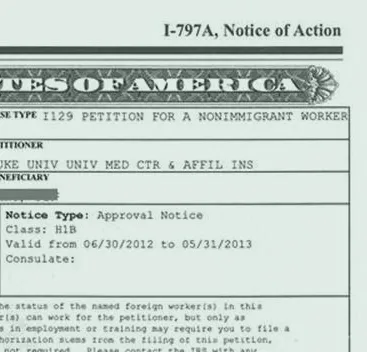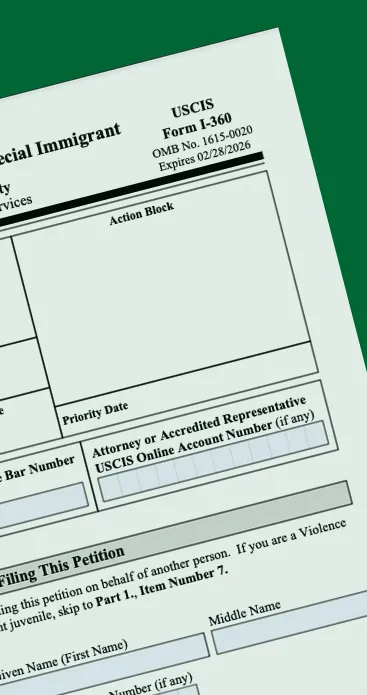MON – FRI (8am - 6pm)
After receiving your i-360 approved what next notice, USCIS will send you Form I-797C, also known as the Notice of Action. This form confirms that your petition has been approved and outlines the next steps you need to take. The approval notice begins the next stage.
It’s crucial to review the I-797C carefully, as it will provide essential information regarding appointments, requests for additional documentation, or any required actions. Need legal solutions? Contact Serving Immigrants, we can guide you through the process.


The I-797C Notice of Action is not just an acknowledgment of your i-360 approved what next but also a roadmap for what to do next.
It often includes dates for appointments such as fingerprinting or interviews. If the notice requests further documentation or follow-up actions, it is vital to respond promptly.
Failure to act could result in delays or even the denial of your permanent residency application. Always keep extra copies of this notice and all related documents to ensure you are prepared for any future requests from USCIS. To discover more of I-797C, click here.

Once your i-360 approved what next step is to apply for an adjustment of status (AOS) to become a permanent resident. To be eligible, you must meet specific criteria.
Firstly, you need to be physically present in the U.S. Secondly, you must file Form I-485, Application to Register Permanent Residence or Adjust Status. See how Form I-485 looks.
Along with this form, you’ll need to submit supporting documents like your birth certificate, passport, and proof of your i-360 approved notice. In addition, you may be required to complete a medical examination by a USCIS-authorized physician to ensure you meet the health standards for lawful permanent residency. Meeting these requirements is essential for Green Card progress.
In addition to the basic eligibility criteria, after your i-360 approved what next is that you must also be "admissible" to the U.S. to qualify for permanent residency. USCIS will review your background, including your criminal history and any past immigration violations. Serious criminal offenses or violations can make you ineligible for adjustment of status. However, some applicants may be eligible for waivers to overcome certain inadmissibility grounds.
It’s important to consult an expert attorney to determine whether you qualify for such waivers and ensure that all necessary documentation is submitted with your application.

If you are not physically present in the U.S., after your i-360 approved what next is that you will need to go through consular processing to obtain permanent residency. USCIS will forward your case to the U.S. Department of State, which will instruct you on how to proceed. You will be required to attend an interview at a U.S. consulate in your home country. This process can take longer than adjustment of status, as it involves coordination between USCIS and the U.S. embassy.
During consular processing, you will need to gather essential documents such as birth certificates, police records, and evidence supporting your i-360 is approved.
Once your documents are submitted, you will attend an interview at the U.S. consulate, where an officer will review your case. They will confirm your eligibility for permanent residency. If successful, you will receive an immigrant visa, allowing you to travel to the U.S. to complete the final steps toward becoming a permanent resident.

Once your i-360 approved what next step is to apply for an Employment Authorization Document (EAD). To obtain an EAD, you must file Form I-765, Application for Employment Authorization, with USCIS. It allows you to support yourself during Green Card processing. File Form I-765 promptly to avoid delays. See how Form I-765 looks
Having an EAD provides several benefits. Firstly, it allows you to work legally in the U.S., which is critical for maintaining financial stability while awaiting your Green Card.
Secondly, it helps demonstrate to USCIS that you are a law-abiding resident contributing to society. Lastly, obtaining an EAD can also facilitate future job opportunities. It’s an essential step, especially for those waiting for their permanent residency to be finalized. Ensure that you renew your EAD annually until your Green Card is approved.

Once Form I-360 is approved, individuals should consider travel restrictions, as there are limitations on leaving the U.S. Details are provided below.
After i-360 approved what next is to be careful when traveling outside the U.S. without proper authorization. While you are waiting for your adjustment of status to be processed, leaving the country without a re-entry permit or Advance Parole may result in being denied re-entry.
Advance Parole allows you to travel outside the U.S. temporarily and re-enter while your adjustment of status application is pending. To apply for Advance Parole, you must file Form I-131, Application for Travel Document, with USCIS. See how Form I-131 looks
However, it's essential to note that Advance Parole does not guarantee re-entry, as U.S. Customs and Border Protection officers have the final say. Always consult an attorney before making travel plans during the adjustment process.

After your i-360 approved what next is to apply for the green card and during the interview to change your status, a USCIS officer will review your application and ask questions to verify the information you provided. The interview confirms accuracy and eligibility for residency.
Questions will typically cover personal details, background, and the supporting documents you’ve submitted. Preparing thoroughly for this interview is essential for a successful outcome, and consulting with an immigration attorney can help. Seeking legal advice? Serving Immigrants offers expert assistance.
To prepare for the Green Card interview, gather all your documents, including copies of your form i-360 approved petition, form I-485, and any supporting materials like birth certificates, marriage records, or proof of employment. It’s also helpful to review your entire case to refresh your memory on key details.
If there are any discrepancies or updates, bring the relevant documentation to the interview. Practicing possible questions with an attorney can also help you feel more confident. It is necessary a proper preparation to increase your chances of success. Contact Serving Immigrants for personalized legal support.
After I-360 approved what next is the adjustment of status, for this the visa availability is a critical factor in determining when you can proceed. The U.S. Department of State issues a Visa Bulletin each month, which lists the current priority dates for different visa categories. If your priority date is earlier than the date listed on the bulletin, you can file for adjustment of status.
Your priority date is the date USCIS received your I-360 petition. After your petition is approved, you must wait until a visa is available based on your priority date and immigration category.
If your date is listed as current, you can move forward with your adjustment of status by filing Form I-485. Staying informed about visa availability ensures that you take action at the appropriate time.

After your I-360 is approved what next sometimes USCIS may issue a RFE to clarify specific details. An RFE is a USCIS request for more documentation or explanations. If you receive an RFE, it is crucial to respond promptly and thoroughly.
In some cases, USCIS may issue a Notice of Intent to Deny (NOID), indicating that your application may be denied unless you provide further evidence or clarification.
Receiving a NOID can be concerning, but it’s important to remain calm and act quickly. A NOID outlines the reasons why USCIS intends to deny your application and gives you a chance to correct the issues. Consult with an attorney immediately to address the concerns raised in the NOID.

Once your I-360 petition approved what next is to wait until your priority date becomes current so you can file Form I-485, Application to Adjust Status. This form is the Green Card application and needs supporting documents. These include a copy of your I-360 approval notice, passport, birth certificate, and a medical examination report from a USCIS-authorized physician. Additionally, you must submit photos, financial documents, and any other evidence.
The filing fee for Form I-485 is substantial, currently set at $1,140, plus an $85 biometric services fee. However, fee waivers are available for certain applicants, such as those with Special Immigrant Juvenile status or individuals unable to afford the fee.
If you are eligible, you can file Form I-912, Request for Fee Waiver, along with your I-485. Ensuring that the correct fees are paid, or a waiver is granted. If you want to read more about Form I-912, click here.

This FAQ section addresses the topic "I-360 Approved What Next" and related concerns.
The timeline to obtain a Green Card after I-360 approval varies. If you are applying for adjustment of status (Form I-485) in the U.S., it can take anywhere from 8 to 14 months. Consular processing outside the U.S. may take longer due to coordination between the NVC and the consulate.
Yes, after your I-360 is approved, you can apply for an Employment Authorization Document (EAD) by filing Form I-765. The EAD allows you to legally work in the U.S. while your adjustment of status or consular processing is pending.
Traveling outside the U.S. after your I-360 approval can be risky if you haven’t yet received your Green Card. You will need to apply for Advance Parole by filing Form I-131. Without Advance Parole, traveling may result in the abandonment of your case, and you could be denied re-entry.
Yes, once you have held your Green Card for at least five years (or three years in some cases), you may be eligible to apply for U.S. citizenship through naturalization. If you're interested in Citizenship, click here.